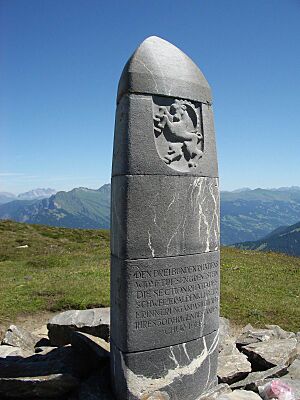Scheid facts for kids
Quick facts for kids
Scheid
|
||
|---|---|---|
|
||
| Country | Switzerland | |
| Canton | Graubünden | |
| District | Hinterrhein | |
| Area | ||
| • Total | 12.32 km2 (4.76 sq mi) | |
| Elevation | 1,221 m (4,006 ft) | |
| Population | ||
| • Total | 148 | |
| • Density | 12.01/km2 (31.11/sq mi) | |
| Postal code |
7419
|
|
| Surrounded by | Churwalden, Domat/Ems, Feldis/Veulden, Malix, Rothenbrunnen, Trans, Tumegl/Tomils | |
Scheid is a small village in Switzerland. It is located in the canton of Graubünden. Scheid used to be its own municipality. In 2009, it joined with other villages like Feldis/Veulden, Trans, and Tumegl/Tomils to form the new municipality of Tomils.
Contents
A Look Back: Scheid's History
Scheid was first mentioned in old writings during the 12th century. Back then, it was known by the name de Side.
Exploring Scheid's Geography
Scheid covers an area of about 12.3 square kilometers (about 4.7 square miles). A large part of this land, about 43%, is used for farming. Forests cover another 42% of the area. Only a small portion, about 2%, has buildings or roads. The rest of the land, about 12%, is made up of rivers, mountains, or other natural areas.
The village is located in the Domleschg sub-district. It used to have two main parts: Unterscheid and Oberscheid. Both of these settlements were found on the right bank of the Hinterrhein river. As mentioned, Scheid became part of the Tomils municipality in 2009.
In the local Romansh language, Unterscheid is called Sched. Oberscheid is known as Purz.
Who Lives in Scheid?
In 2007, Scheid had a population of 148 people. A small number of these residents, about 2.7%, were foreign nationals. Over the ten years before 2007, the population of Scheid grew by about 8.8%.
Population Over Time
The number of people living in Scheid has changed over many years. Here is a quick look at how the population has grown or shrunk:
| year | population |
|---|---|
| 1803 | 219 |
| 1850 | 222 |
| 1900 | 156 |
| 1950 | 154 |
| 1960 | 136 |
| 1970 | 104 |
| 1980 | 116 |
| 1990 | 115 |
| 2000 | 139 |
Education and Work in Scheid
Most adults in Scheid have a good education. About 69% of people aged 25 to 64 have finished either advanced high school or gone on to higher education, like university.
In 2005, many people in Scheid worked in farming. There were 36 people working in the farming sector, with 16 businesses. A few people worked in manufacturing, with 4 people and 2 businesses. Only 1 person worked in the service sector, with 1 business.
Languages Spoken in Scheid
Most people in Scheid speak German. In 2000, about 79% of the population spoke German. The second most common language was Romansh, spoken by about 19% of the people. A small number, less than 1%, spoke Portuguese.
The table below shows how the main languages spoken in Scheid have changed over the years:
| Languages | Census 1980 | Census 1990 | Census 2000 | |||
|---|---|---|---|---|---|---|
| Number | Percent | Number | Percent | Number | Percent | |
| German | 44 | 37.93% | 72 | 62.61% | 110 | 79.14% |
| Romanish | 69 | 59.48% | 42 | 36.52% | 27 | 19.42% |
The Dreibündenstein Monument
The Dreibündenstein is a special stone monument. Its name means "Three Leagues Stone" in German. In Romansh, it's called Term bel. This stone marks the spot where the borders of the Three Leagues met. These three leagues were important groups that came together to form the modern canton of Graubünden.
The monument is located high up on a mountain, at about 2,160 meters (7,087 feet) above sea level. It sits on the border between the municipalities of Domat/Ems, Scheid (now part of Tomils), and Malix.
The very first stone marker at this spot was from 1722. Today, that original stone is kept in the Rätian Museum in Chur. In 1742, a writer named Nicolin Sererhard mentioned that there were three stones there. The current stone monument, which is 2 meters (about 6.5 feet) tall, was built in 1915 by a group called the Sektion Rhätia of the Swiss Alpine club. In 1970, a chair lift was added to the mountain, making it much easier for people to visit the Dreibündenstein.
See also
 In Spanish: Scheid para niños
In Spanish: Scheid para niños





